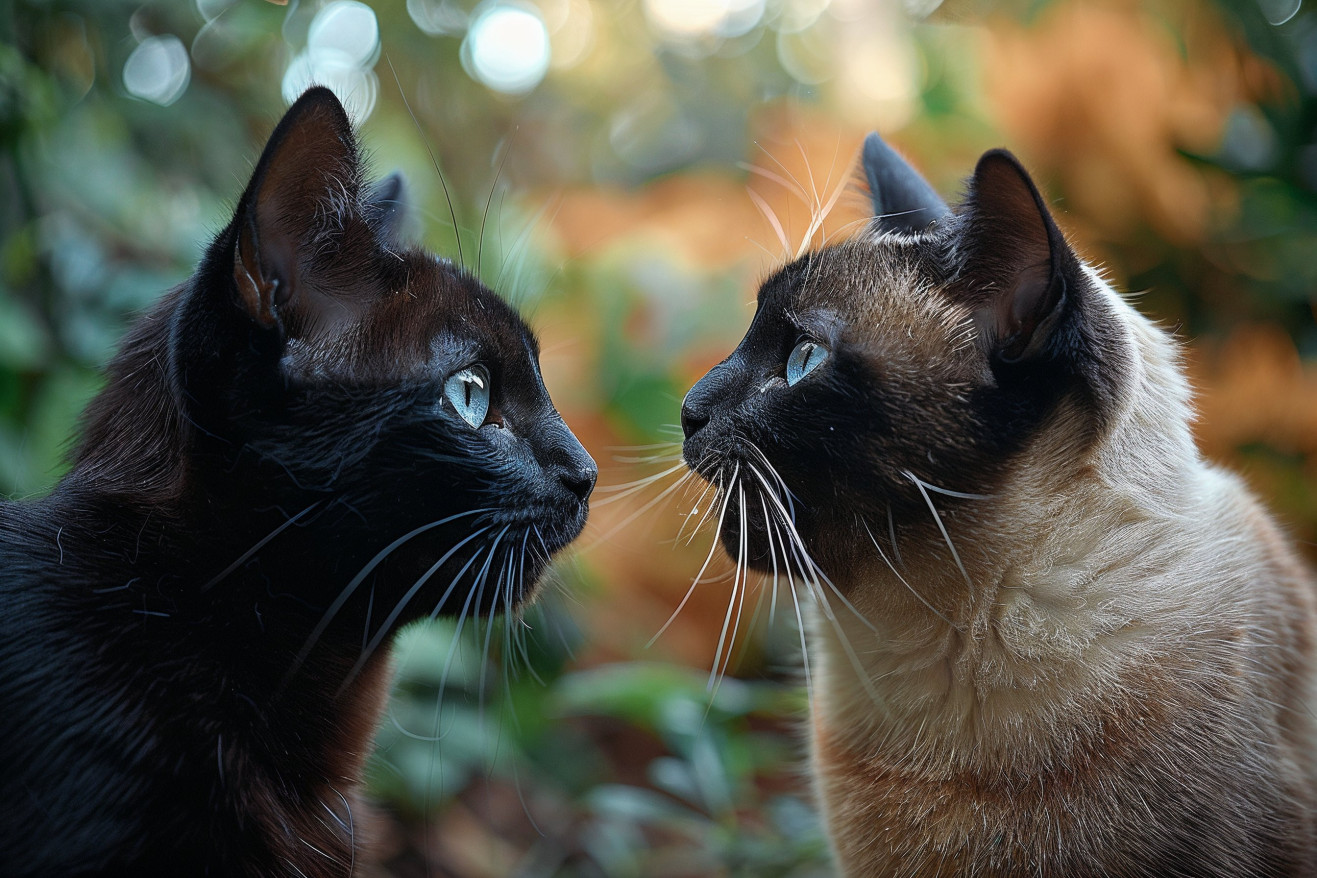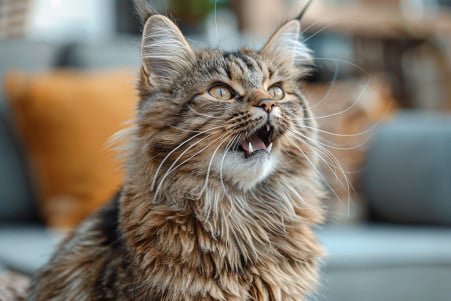Why Do Cats Scream When Mating? The Science Behind Cat Mating Calls
22 February 2024 • Updated 22 February 2024

The yowling cries that accompany the mating of cats are more than just noise; they are a call of nature. Cats scream when mating because of the pain that the male cat’s barbed penis causes the female upon withdrawal. This pain may also help induce ovulation, since cats are induced ovulators. Vocalization is a normal part of the mating process for felines.
In this article, we will explore why cats scream when mating by drawing on studies from veterinary science, ethology, and neurobiology. By taking an interdisciplinary approach, we can gain insight into the physiological, hormonal, and communicative mechanisms that drive this behavior. By delving into these scientific fields, we can build a more complete picture of the complex relationship between biology and behavior that leads to this unique feline vocalization.
Why do cats scream when mating?
The Science of Cat Mating: Barbed Penises and Induced Ovulation
The barbed penis is just one of the many anatomical features that are involved in the complex biological process of cat mating. It turns out that the barbs on the male cat’s penis are not just there to cause the female pain, as some have suggested, but instead have a clear evolutionary purpose.
According to a study in PMC, the barbs on the male cat’s penis stimulate the female cat during copulation, leading to a hormonal surge that is necessary for ovulation, a phenomenon called induced ovulation.
The female’s reaction to the barbed penis is complex and can involve pain that leads to the screaming that is so often associated with cat mating.
The female cat’s screams during mating are not a sign of distress but instead are part of the cat’s natural reproductive strategy. Knowing this helps to debunk the myth that female cats are in pain during mating. While it can be distressing to those who don’t understand what’s happening, it’s actually a normal and necessary part of the cat’s reproductive process.
A deeper look into the role of the screams also shows that they have more to do than just signaling pain, it also looks at communication and behavioral ecology.
Vocalizations and Cat Mating Behavior
Mating in cats is accompanied by a variety of vocalizations, each with a specific communicative function. The domestic cat’s vocalizations are especially diverse, with a range of sounds that go beyond the basic meow to include vocalizations that can signal sexual receptivity and even sexual interest.
These sounds include the classic caterwaul, which is often associated with female cats in heat, as well as quieter chirps and trills that may be part of the courtship process. According to a study in PMC, this diversity is part of a complex communication system that has evolved to maximize reproductive success.
The vocal signals that cats use during mating are important. For example, when a female cat makes loud vocalizations, she is letting males know where she is and that she is available, which can change the way that males behave and even lead to competition for her attention.
Males, in turn, may use specific vocalizations to let females know where they are and that they are ready to mate. A study in the journal Animal Behaviour titled “Visual classification of feral cat Felis silvestris catus vocalizations” highlights the importance of these vocal signals in the complex mating behaviors of cats.
This insight into the vocalizations of cats also provides a window into the evolutionary advantages of communication during mating, when the ability to successfully reproduce depends on clear communication between partners. The back-and-forth of calls and responses helps ensure that only the most receptive and prepared individuals mate, demonstrating the power of vocal communication in the animal kingdom.
Domestication and the Evolution of Cat Vocalizations and Mating
The transition from wild ancestors to domestic pets has impacted many aspects of cat behavior, including vocalizations and mating. A study comparing European wildcats and domestic cats, cited by ScienceDirect, found that while the two species have many similarities, the differences that exist in the domestic cat are likely due to their long history of living with humans.
For example, domestic cats exhibit behaviors like “individual sleeping” more than wildcats, which indicates that their natural behaviors have been altered by domestication.
In addition to the ways that domestic cats have evolved in response to living with humans, selective breeding and human intervention have likely impacted their vocalizations and, in turn, their communication during mating, according to a study by Lauren R. Finka published in PMC.
Not only has domestication potentially changed the way cats vocalize, it has also impacted the situations in which they vocalize, which in turn has impacted their mating behaviors. This is particularly important to consider in terms of the welfare of domestic cats, especially since their living conditions and social structures are now largely determined by humans.
Recognizing these differences helps to show how domestication has impacted the communicative vocalizations of our pet cats and can inform welfare policies that honor their natural behaviors while adapting to their current living situations.
Understanding the Mating Calls: Hormonal and Neurological Mechanisms
The seemingly endless wails of the mating cats are the result of a complex hormonal and neurological process. A surge of hormones, including luteinizing hormone (LH) and estradiol-17β, are responsible for the mating process, according to a study in Biology of Reproduction by David E. Wildt and colleagues. These hormones are responsible for inducing ovulation in the female cat, which is crucial for successful mating.
Neurologically, the mating calls are the result of an instinctual response to mating stimuli that is hardwired into the cat’s brain. As Andreas Nieder explains in Philosophical Transactions of the Royal Society B: Biological Sciences, vocalizations are an ancient vertebrate trait that is often instinctual and tied to the animal’s emotional state.
The pain that is induced by mating, while uncomfortable, is also important in a physiological sense because it helps to induce ovulation. This pain, and the vocalizations that follow, are part of a sensory and affective experience that helps to signal reproductive readiness and fitness. This means that the hormonal and neural responses to mating, as well as the pain that is experienced, all come together to create the mating calls.
Comparative studies, including those in the NCBI Bookshelf on the recognition of pain in animals, have shown that vocalizations are a common response to pain in animals, but the way that pain is expressed is different in each species.
Recognizing the balance between the discomfort and the necessity of the pain for reproduction is an important insight into the behavior of our feline friends, and it also underscores the importance of ensuring that their welfare is taken into account during the mating season.
How to Deal With the Cat Mating Season: Tips for Cat Owners
Cat owners must be aware of and understand the behaviors associated with the mating season. For example, unspayed female cats will yowl, roll, and act restless, which can be mistaken for being in distress. However, these are all signs that the cat is in heat.
Meanwhile, unneutered male cats will become more territorial and may start spraying to attract females. These behaviors can be managed by creating a calm, safe space for the cats and using pheromone diffusers to help calm them down.
The Merck Veterinary Manual explains that the best way to control these behaviors and prevent overpopulation is by spaying and neutering cats. It’s also important to note the difference between normal mating vocalizations, which include loud yowling and growling, and distress, which can include crying continuously or aggression after mating.
Cat owners can get help and advice from sources like the Merck Veterinary Manual and from their own veterinarians. The most important thing is to make sure that cats are safe and healthy during this natural but sometimes difficult time. Spaying and neutering not only help cats live healthier lives, but they also help animal welfare by preventing unwanted kittens.
Echoes of Nature: The Science Behind the Mating Call
In discussing the many factors that contribute to feline mating behaviors, we can now better understand the yowling that results. Both the physical and behavioral causes of this vocalization show the biological and evolutionary complexity of cat mating. The barbed structure of the male cat’s penis, the hormonal changes that lead to ovulation, and the female’s vocal response are all evolutionary changes that have helped the species survive.
This is also where responsible pet ownership comes into play. It’s important to know the difference between a mating call and a call for help in order to make sure that our pets are safe. The way that domestication has impacted these behaviors also shows that our influence on animals means that we have to be responsible, knowledgeable, and compassionate caretakers.
This look at cat communication also shows how biology, behavior, and domestication all come together to create the chorus of sounds that make up the cat’s vocal repertoire. In the end, it’s important to remember the value of ongoing research into the world of cat communication, which will only continue to expand our knowledge and understanding of these mysterious pets.


